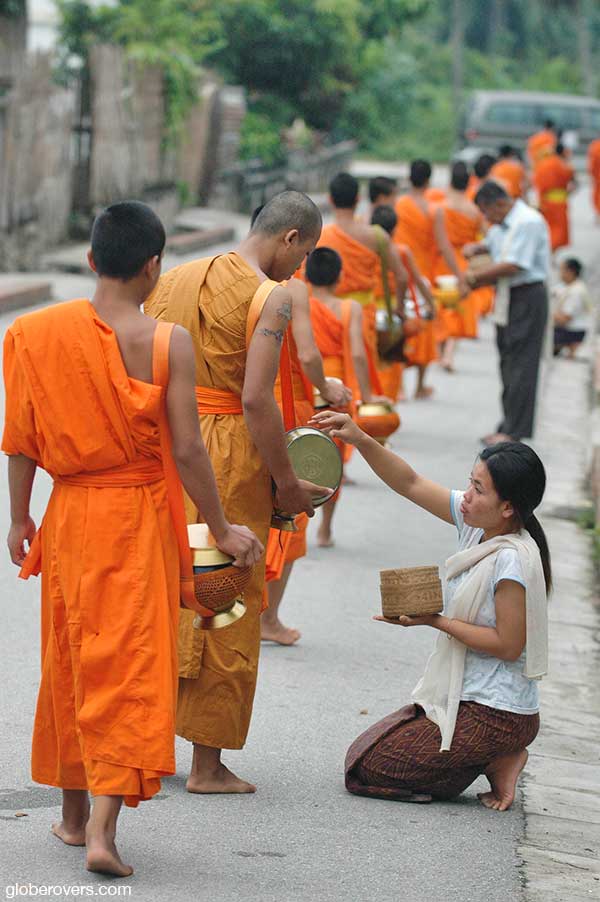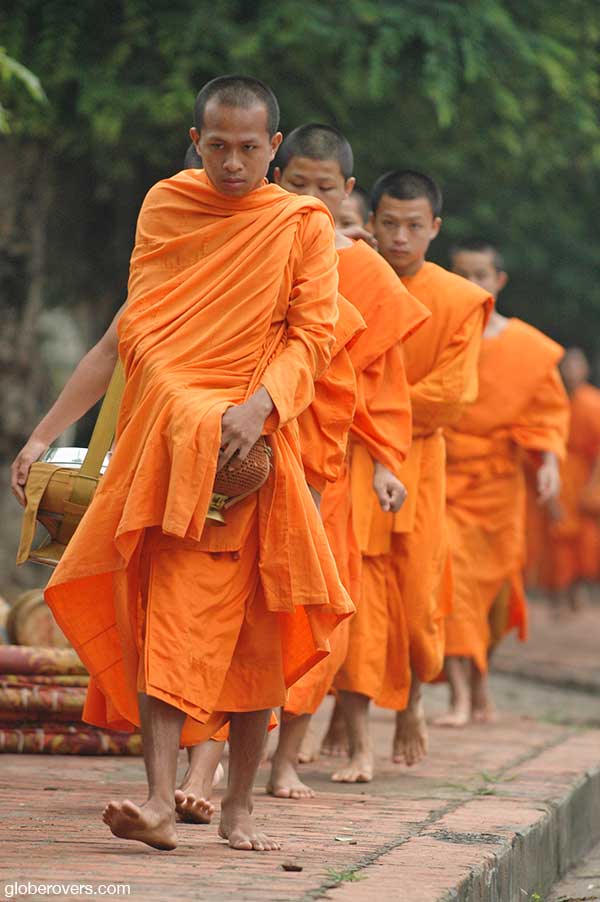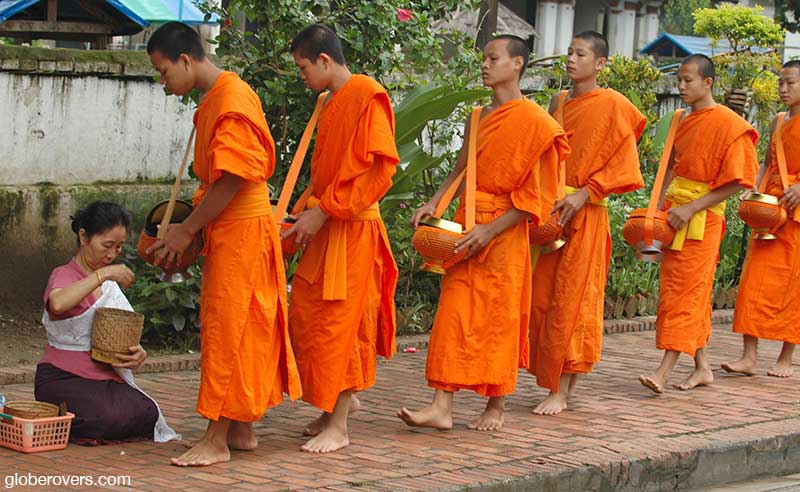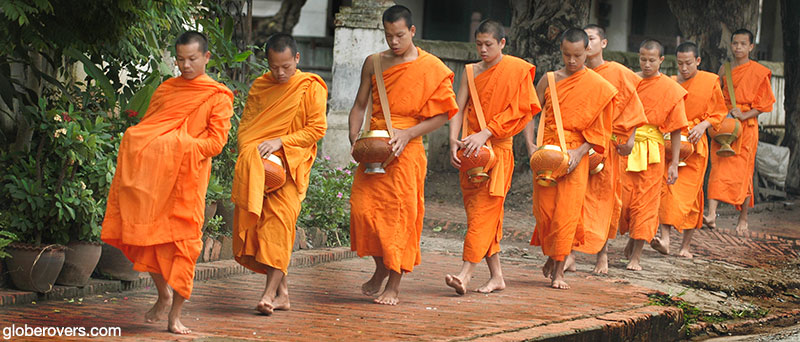
Laos is diverse and rich in scenery and activities, catering to the needs of most adventurers, culture seekers, Buddhist aficionados, and even the foodies! We travelled north of the capital, Vientiane and on to Luang Prabang and its many hill tribes. In a separate blog post, we go all the way down to the far south to visit the 4,000 islands in the Mekong River for a tranquil experience.
While there is no longer a million elephants in Laos, this landlocked country is packed with adventure!
Why travel to Laos?
- The low-down: While Laos lacks the beaches we so love in the rest of Southeast Asia, Laos makes up for it in many other ways!
- The brightest highlight: The monasteries and monastic lives of Luang Prabang. Rise before sunrise to witness the ritual of monks peacefully lining up to receive alms.
- Intrepid destination: Absolutely, Laos is one of the most unexplored and underrated countries in the region. Get away from the few tourist spots and you are intrepid king!
- Globerovers score (10 is highest): While I still have not been north of Luang Prabang or the eastern part and south between Vientiane and Pakse, I’ll score Laos 7/10.
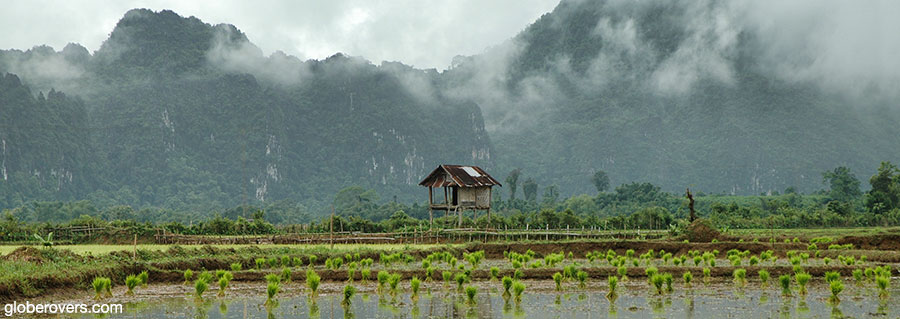
Table of Contents
Welcome to land-locked Laos
Laos more renowned as “the most heavily bombed country in history relative to the size of its population” than as a popular tourist destination.
During the Vietnam War, the US Army dropped about two million tons of ordnance during 580,000 bombing missions, mostly in the western region of the north and the entire southern region of Laos. This is equal to a planeload of bombs every 8 minutes, 24-hours a day, starting in 1964 and lasting until 1973. All this in an effort to disrupt supply lines being used by the communist Vietnamese forces.
The most heavily bombed country in history!
Though the bombing ended in Laos in 1973, over the next two years a Vietnam and Soviet-backed civil war raged and brought the communists of the Pathet Lao political party into power.
While the communists of the Lao People’s Revolutionary Party (LPRP) remain in power today, the war is long forgotten.

Once you have travelled through this narrow country, which shares a border with Vietnam of over 2,000 km long, and a border with Thailand of almost 1,800 km long, you will know that the war is not talked about. Except for the estimated 80 million cluster bombs that did not detonate, most of which are still buried in the jungles and farmlands, few signs remain of the war.
Since the war ended, over 20,000 people have been killed or injured by unexploded ordnance. Efforts to clear these dangers are ongoing, so accidents have decreased from 310 cases back in 2008, to about 50 per year nowadays.
Most travellers who have visited Laos are left with memories of friendly people, colourful temples, monasteries and monks, the mighty Mekong River, dense tropical jungles, and rice paddy workers surrounded by imposing limestone rocks. While I have come to see it all, my calling was to share a few days in the lives of the ethnically diverse tribes, the monks and their monasteries, all in harmony with the Mekong River.
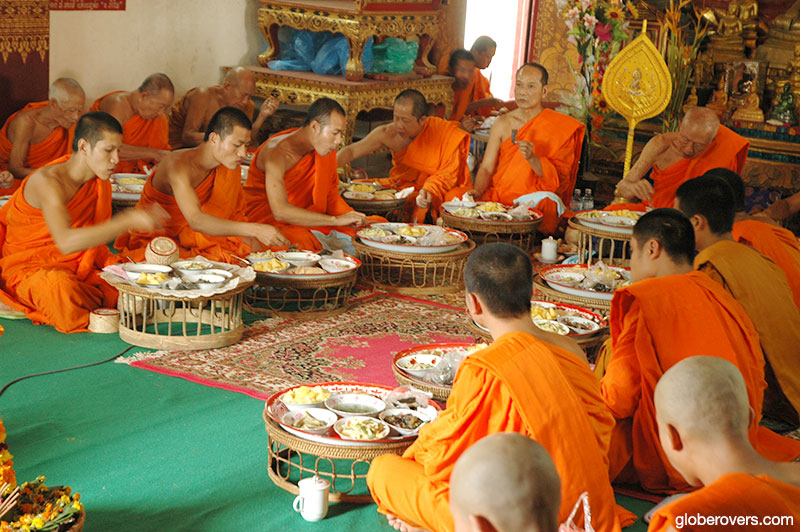
While only about 60% of the Lao people are Buddhist, compared with 95% in Thailand, 90% in Cambodia, and 88% in Myanmar, in Vientiane and Luang Prabang Buddhist temples and monasteries are found around almost every corner. Luang Prabang is known particularly for its many temples, monasteries, and barefoot saffron-clad monks collecting alms at sunrise.
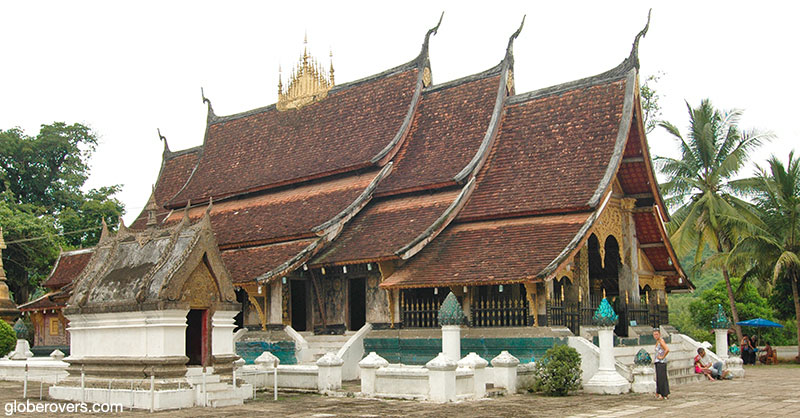
Start the journey in the Lao capital of Vientiane, the most popular entry point to the country. From here, travel about 160 km north to Vang Vieng, a popular town among backpackers, known for its relaxing vibes and excellent hiking among limestone karst with steep cliffs and rice paddies.
From Vang Vieng, the winding road snakes over high mountain passes, often covered in thick fog, before descending into Luang Prabang. After a few days in and around this lovely town with its many temples and hill tribes, head north along the Mekong, and then down to the most southern point of the country to explore some of the 4,000 islands smack in the middle of the Mekong River.
Come along as we find out what makes Laos such a special destination to travellers.
Laos used to be known as Lan Xang, meaning “The Land of a Million Elephants”. After years of war and loss of habitat, there are not many left…
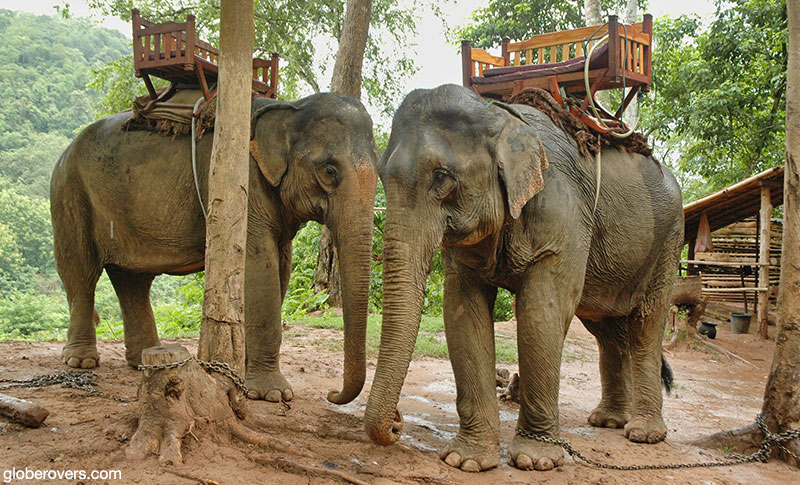
The Lao capital – Vientiane
Located on the banks of the Mekong River near the border with Thailand, Vientiane is not the sleepy town it used to be, though it still seems to be dreaming. Most travellers who have walked through the arch of the Patuxai, Vientiane’s Gate of Triumph and the Lao version of the French Arc de Triomphe, will agree that Vientiane was not their reason for visiting this country.
The languid former French trading post is slowly waking up to the world.
While the capital cities of neighbouring Thailand, Myanmar, Vietnam, and even Cambodia can keep travellers entertained for days, if not weeks on end, the Lao capital remains a rather subdued town.
The laid-back capital of Laos has a tranquil historic old quarter with golden temples and Buddhist monks, surrounded by wide boulevards.

Vientiane, which became the capital of the Kingdom of Lan Xang (now Laos) in 1563, was invaded and looted (they took back the Emerald Buddha) by the Siam forces (now Thailand) in 1778, and again looted by the Siamese during the Lao Rebellion (1826-1828).
Among the most notable attractions not to miss are the Pha That Luang stupa, Haw Phra Kaew temple which is the former home of the Emerald Buddha, the Patuxai Arch, and the lazy barbecue dinner evenings along the Mekong River.
Pha That Luang
Known as the “Great Stupa”, Pha That Luang is the most sacred Buddhist stupa and a national symbol of Laos. This large golden stupa dates back to the 16th century and stands 45 metres high. According to folklore, a Hindu temple first occupied this spot during the 1st to 3rd centuries to house a holy relic, likely a breastbone, of the Lord Buddha, brought to Laos by an Indian missionary.

During the 13th century, a new Khmer temple replaced the original. However, King Setthathirat erected the current structure in 1566 when he moved the Lao capital from Luang Prabang to Vientiane.
The King’s statue stands in front of the main entrance to Pha That Luang. Looted of much of its gold plates by the Burmese, Chinese and Siamese during invasions in the 18th and 19th centuries, it was all but destroyed by the Siamese invasion in 1828. The stupa was restored by the French colonialists in 1900 and reconstructed in 1930, and again after World War II.
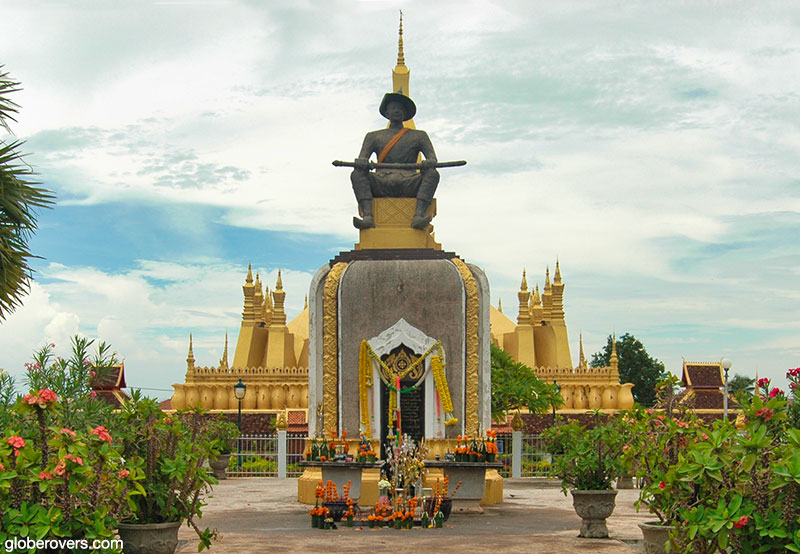
During November every year, the stupa is the centre-point of the annual Boun That Luang Festival.
Haw Phra Kaew
First built in 1565 to house the Emerald Buddha, which now resides in Bangkok’s Grand Palace, Haw Phra Kaew has been rebuilt several times, most notably by King Anouvong in 1816, and the French between 1936 and 1942. In the 1970’s the temple was converted from a place of worship to a museum of Lao religious art.

Wat Si Saket
Very similar in design to Haw Phra Kaew, nearby Wat Si Saket is famous for its cloister wall housing thousands of tiny Buddha images and rows with tens of larger seated Buddhas dating back to the 16th and 19th centuries. If you count all the Buddha images made from wood, stone and bronze, you may get a total of 6,800 in total!
Built in 1818 on the order of King Anouvong, the temple served as the lodging place of the 1928 Siamese invaders and was therefore spared destruction.
Wat Si Saket was restored by the French in 1924 and 1930 and is now regarded as one of the oldest Buddhist temples in Laos.
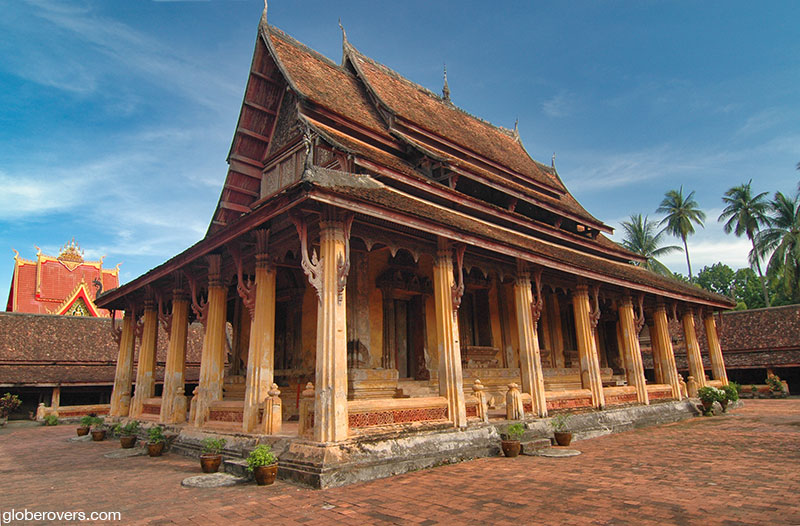
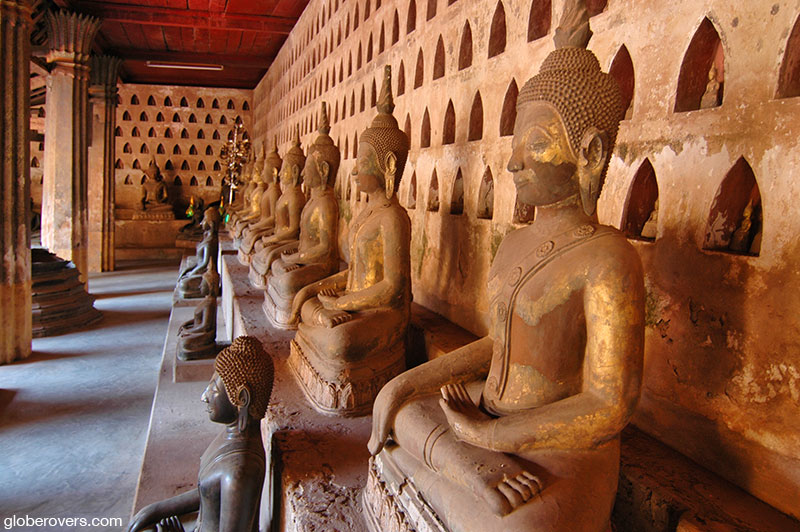
Wat Si Muang
Just about 1 km to the southeast of Haw Phra Kaew and Wat Si Saket is the 16th century Wat Si Muan temple. Destroyed during the Siamese invasion in 1828, it was rebuilt a few times. The current temple dates back to 1915.
While the building itself is fairly unremarkable, legend has it that the temple was named after a woman called Si Muang, who sacrificed herself to appease the evil spirits by throwing herself into the pit that holds the central pillar of the structure. Look out for a small statue of this lady at the temple.
Many worshippers come here to make merit and be blessed by the resident monks. The temple was also home to an old and rather bad-tempered and territorial stork, though it recently passed away.
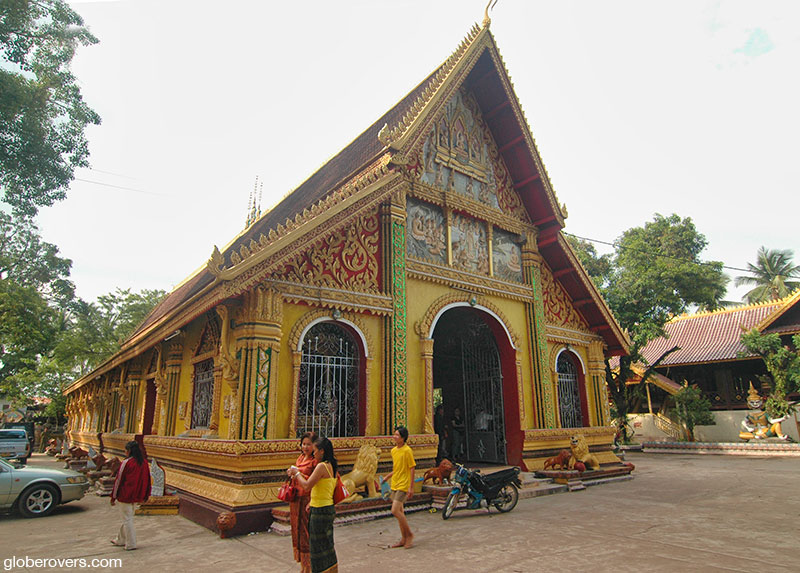

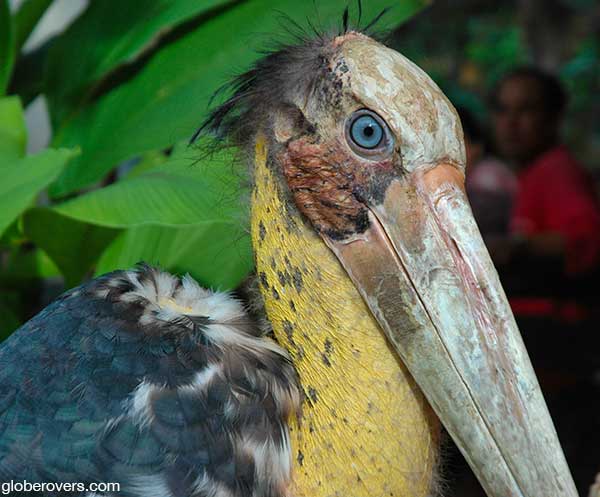
Patuxai Arch
The Victory Gate or Gate of Triumph, known among travellers as the “Arc de Triomphe of Vientiane”, was constructed between 1957 and 1968 to honour those who fought in the struggle for independence from its earlier occupiers: France, Siam and Japan.
The Royal Laotian Government built the monument by reassigning American funds intended to build a new airport, hence its nickname of the “vertical runway”.
Known originally as the Anousavali (memory) monument, it got its current name when the Pathet Lao communists overthrew the Lao monarchy during the 1975 Laotian Civil War.
For a small entrance fee, climb to the top of the arch for panoramic views of Vientiane and Thailand across the Mekong River.
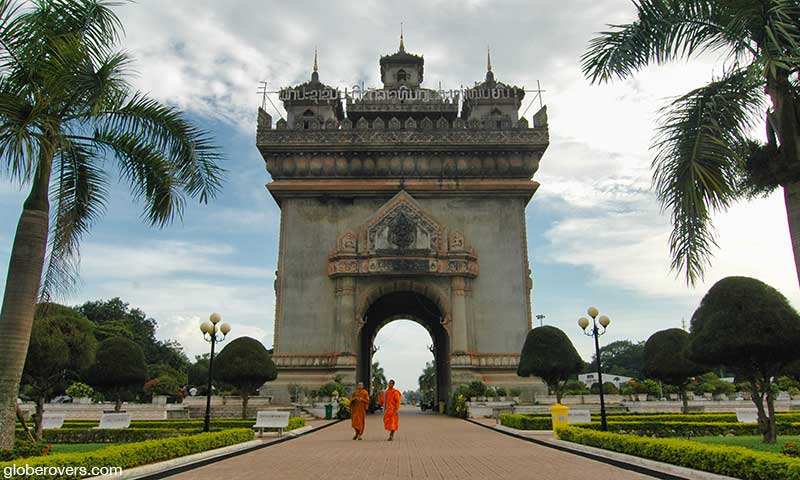
That Dam
Known as the “black stupa”, That Dam used to be covered in gold until it all disappeared during the Siamese invasion in 1828. According to local folklore, it once was inhabited by a seven-headed dragon or snake that tried to protect them from the invading Siamese.
Standing on a quiet roundabout near the Talat Sao morning market, the crumbling and weatherworn structure seems to be totally unbeloved and neglected. However, being so obscure, non-glittering, and almost natural looking, the stupa shows “its unadorned self”, and one can stare at it and imagine its turbulent history.
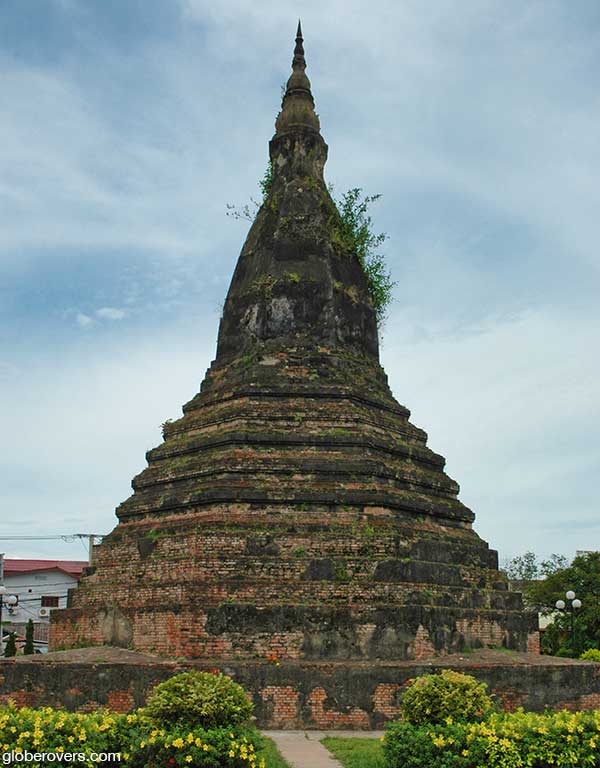
Wat Ong Teu Mahawihan
Famous for its large bronze Phra Ong Teu Buddha image, the largest Buddha in Vientiane, the temple was constructed during the 16th century by King Setthathirat.
Demolished by the Burmese and Siamese invaders, the temple has been reconstructed several times.
The temple is known as an educational institute teaching Theravada Buddhism. Hidden behind a large, ornamented gate, the temple’s cold floor tiles and rich architecture is a welcome retreat from the heat and noise of the Vientiane streets.
You most likely will come across several bright orange-robed monks who study here and live in the adjacent blue, red and white monastery.


Tad Moun Waterfall
About 20 km west of Vientiane, located at the southern tip of the Phou Phanang National Bio-Diversity Conservation Area, Tad Moun Waterfall, though more akin to mild rapids, makes for a pleasant day visit out of the city. Spend the day hiking through the jungle, splashing in the rapids, or just lazing under the small thatched huts while enjoying a picnic lunch and Beer Lao.
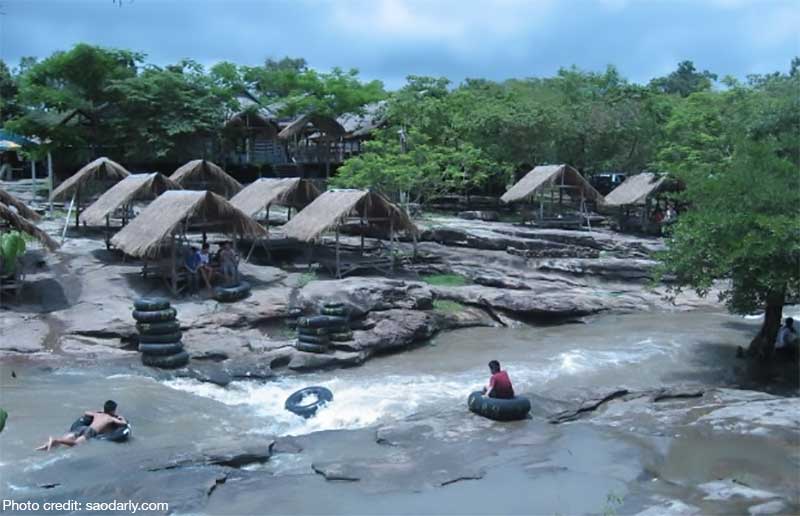
Mekong River Sunsets And Night Market
After a long day of temples and monasteries, check out the Vientiane night market for some interesting foods, and then go and grab a few beers and enjoy the sun’s spectacular show as it sets over the Mekong River.
A festive atmosphere rules as people, sitting at their blue and red plastic chairs and tables, drink Lao Beer and watch the sunset over the slow-flowing river.
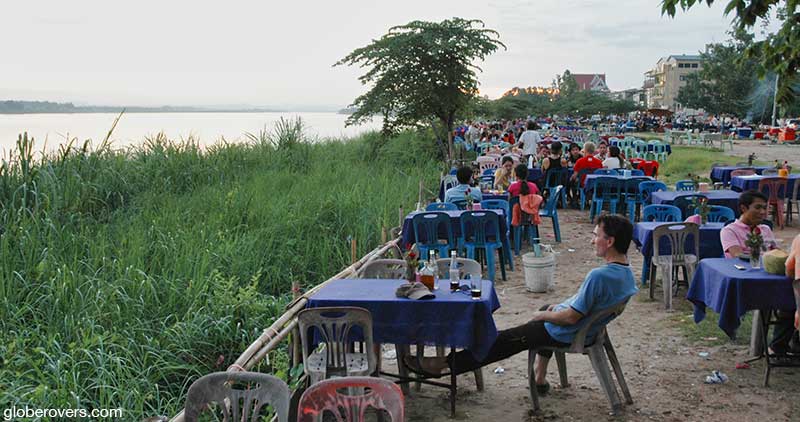
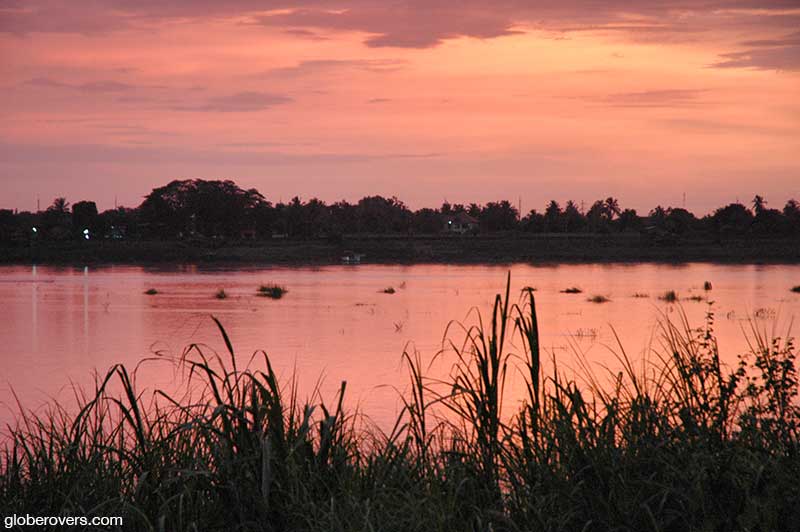
Vang Vieng – base for adventure
On the eastern banks of the Nam Song River, just 160 km north of Vientiane on the Luang Prabang road, lies the small town of Vang Vieng. The town, settled in the 14th century, was originally known as Mouang Song but was renamed by the French colonial rulers in the 1890’s as Vang Vieng.
Vang Vieng is a pleasant stop between Vientiane and Luang Prabang – though you may not want to leave again.
The area’s towering limestone karst with mysterious caves, combined with the town’s location next to the Nam Song River, created a reputation of a remote destination where adventure and relaxation lived side by side.

Over the past two decades, it has become a popular place for backpackers in search of nirvana. While some came for the hiking, cycling among rice paddies, climbing of the sheer limestone cliffs, exploring the caves, tubing down the river, kayaking, and swimming in the lagoons, too many travellers came here for the rough parties of endless drinking, smoking, and the beer bars serving pasta and pizzas along the main drag.
Slowly they would get stoned while watching pirated copies of Seinfeld and Friends at the bars decorated with Rastafarian flags.
Vang Vieng has recently been reborn after years of being an out-of-control party-den for backpackers. Now the focus is again on nature and tranquility.
Some stayed for days on end, some never left, some even died.

Fortunately, a few years ago the government intervened and now the place is no longer its former hedonistic playground but has become more subdued, and the natural surroundings are once again the main course on the menu.
The type of traveller coming to Vang Vieng has changed in the process, with more Asian visitors such as Chinese people often arriving in large groups. The type of accommodation is also changing from being mostly basic backpacker lodging to larger hotels such as the Riverside Boutique Resort and the Amari Vang Vieng, catering to more upscale clientele and large groups.
Vang Vieng will never be the same.

If the action on the main street is not for you, it is easy to escape. Head across the river for some tranquillity, where basic as well as more luxurious cottages are located on the west bank of the river. Highly recommended are the Pasanchai Bungalows right next to the river.
Hire a bicycle, cross the river to the west side, and just follow the small roads leading past an uncountable number of limestone karsts and rice paddies. Don’t hesitate to interact with the locals, even while they are tending to their rice paddies. These people are generally welcoming and not too camera shy, but always ask permission before clicking away.
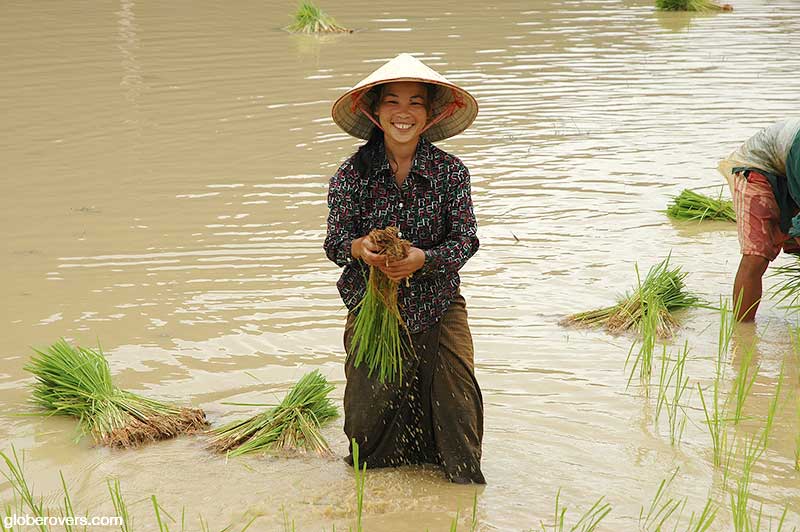
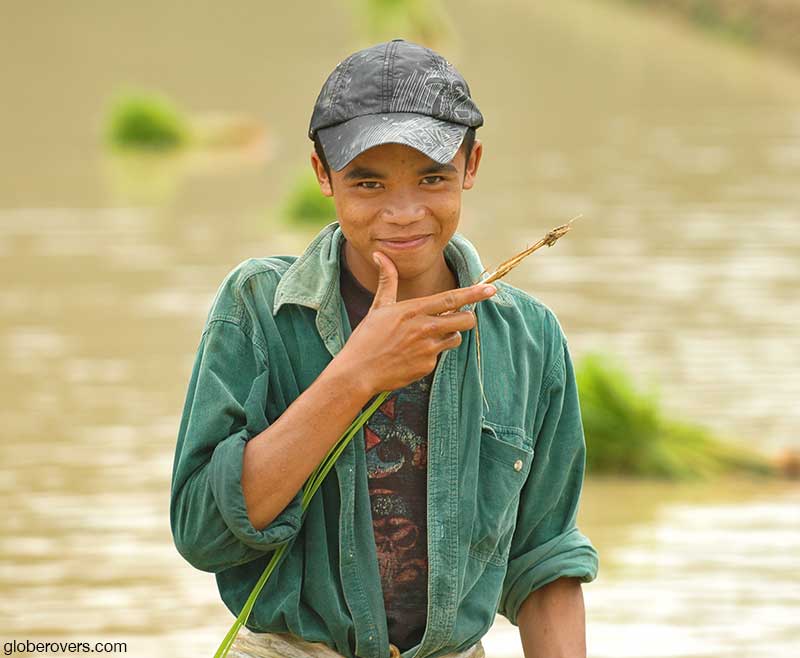
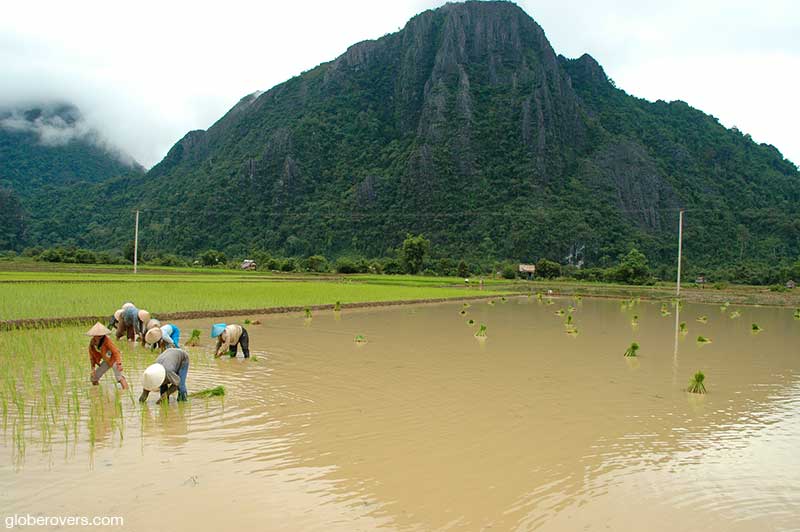
While Vang Vieng is not the place where you would come and search for authentic Lao culture, cycling out of town does offer ample opportunities to interact with the locals and to witness their traditional way of life.
About 8 km to the west of town near the village of Ban Na Thong, lies Tham Phu Kham cave and a beautiful bluish lagoon.
The road you will travel to get here is beautiful as it passes through the countryside littered with karst rock formations, tiny villages and endless rice paddies.
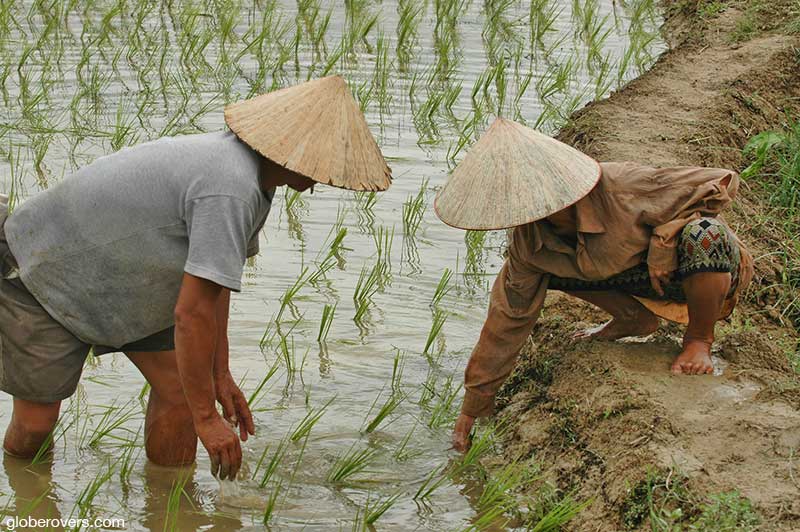
The cave’s entrance is about halfway up the limestone cliff along a hiking trail through the lush forest. The climb to the entrance is steep in some sections, but a handrail is available for a good grip. It’s worth the climb as the cave offers a labyrinth of chambers decorated with stalagmites and stalactites. A large reclining Buddha in the first chamber will welcome you. With a flashlight and some help from the streaming sunrays, you can explore vast areas of the cave system.
Done exploring the cave, head back down and plunge in the crystal-clear waters of the lagoon, a serene natural paradise. Local kids jumping from the trees into the lagoon will likely entertain you.
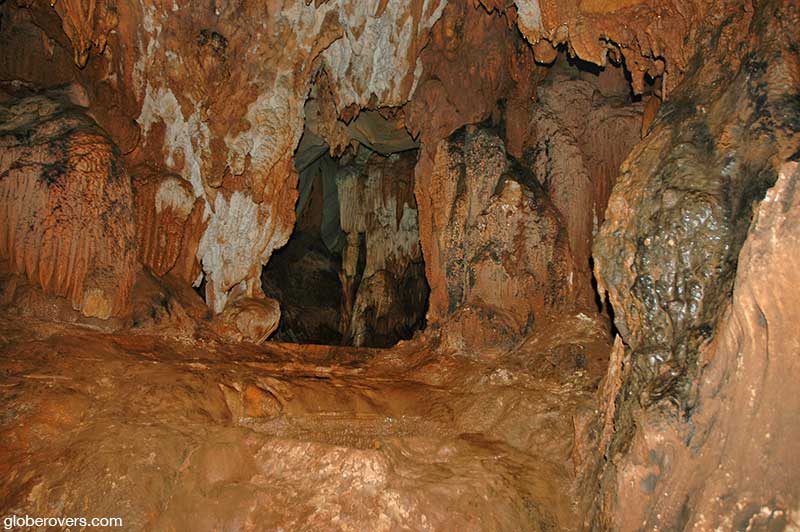
Hard to believe that from the 1950’s to 1970’s this area was home to an American air base known as Lima Site 6, along Route 13, from where bombing raids were launched. Of the asphalt airstrip, little but a crumbled potholed strip is still visible, with most of the visiting travellers unaware of it and its history.
Despite Vang Vieng not being the sleepy village it used to be some time ago, and the changing demographics in recent years, it remains a beautiful place where tranquillity is not far away. Here you can cycle for hours among some of the most beautiful natural scenery you have ever come across. Lakes, lagoons, rivers, caves with underground lagoons, and so much natural beauty.
If you have travelled around Laos to enjoy the local cuisines, which may not always be as delicious as you were hoping for, you will be happy to know that your old favourite dishes are available in Vang Vieng. Try the Thai and Chinese restaurants, pizzas, burgers, and some great French-owned bakeries. Le Cafe de Paris and Gary’s Irish Bar will not disappoint you.
Road To Luang Prabang
Once you are done with Vang Vieng, hop onto one of the many public buses, “VIP buses”, minivans, or cars, which head up northwest to Luang Prabang on the scenic, winding, and nauseating mountain road.

The “original” road goes from Vang Vieng on Road 13 through Kasi, Vieng Kham, and Phou Khoun and takes roughly six to seven hours, depending on which vehicle you choose, how many stops it makes, and how long passengers spend at each stop. Unscheduled stops are often required for dizzy and nauseous tourists, in particular those who chose the minivans. The road is very scenic and a stop or two in the high elevations is usually on the cards.
It’s the journey that counts and not the destination. So true for this road!
The Hmong people are some of the poorest people of Laos living along this route. They are increasingly catering to the needs of the visiting tourists, but still mostly go about their own way of life. As the ladies are selling their farm produce and ready-to-eat fried foods, the kids play along the main road, chasing puppies and harassing the chickens. Vans, buses and cars speed through these villages and I wonder how often these kids get run over.
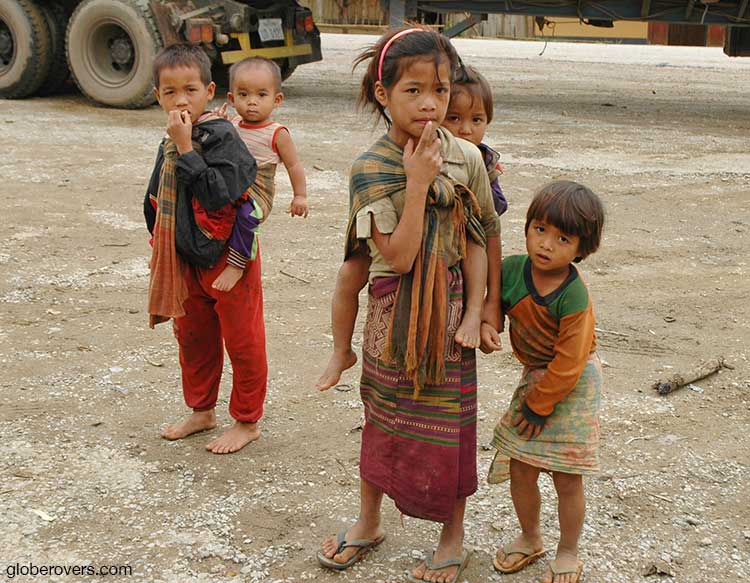

Life at this high elevation is tough, as you will see etched on the locals’ faces. High elevation villages are often shrouded in fog and smog, and it can get quite cold. There seems to be a constant slash-and-burning of the hills with a thick smoke-haze blocking out the blue sky. Many of the fire-ravaged hills are left with brown scars, devoid of the green jungle it once was. Unfortunately, the Lao government is too busy entertaining the Chinese Government’s investments in hydroelectricity projects and large-scale food production for the China market to care about the well-being of the Hmong and their unsustainable exploitation of their natural environment.
The mountain road from Vang Vieng to Luang Prabang is a pure sensory adventure.
The food stalls sell interesting local Hmong delicacies, including “khai look”, a boiled duck egg with an embryo that is eaten from the shell. You will also find “mok pa” which is catfish, or other local river fish, steamed in fresh banana leaves. Sun-dried strips of beef jerkies called “sien savahn”, and some “sai oua” or “sai gork” Lao sausages are also usually on offer. It is a sensory experience to try this food. Don’t fear. If the Lao people can eat it, then so can we all.
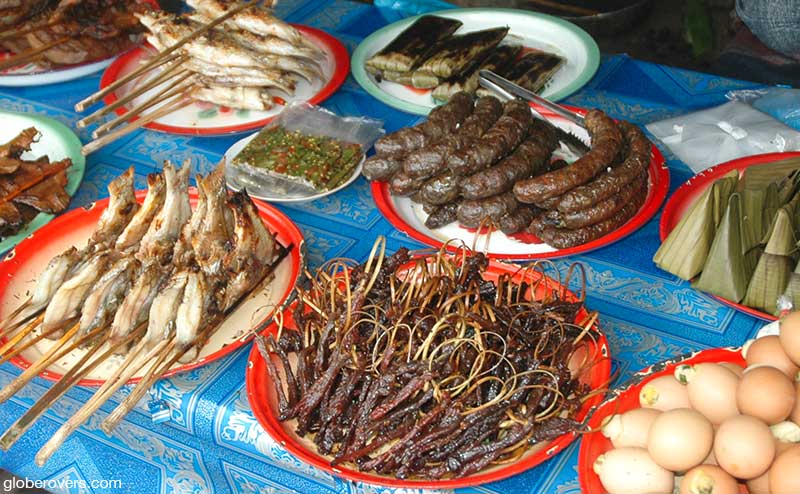
The so-called “new road” between Vang Vieng and Luang Prabang is an upgraded old road which forks west at Kasi through the mountains to Road 4 from where it later rejoins Road 13 just before arrival at Luang Prabang. The new road takes about five hours, so is about one to two hours faster, mainly because there are less scenic points to stop at, and it is less winding than the old route. If you have a choice, take transportation that follows the old road all the way via Road 13, but before boarding tell the driver to please take it easy and to get you to Luang Prabang alive.
Make sure he will at least stop at a few scenic spots along the way. Having a private car and driver is the most desirable way to do this route. Note that there have been incidences of violence along this route, and further off the route, though not directly targeting foreign travellers. Also, note that large buses can only take the old route due to steep hills on the new route.
You will be relieved when you arrive at your destination!
Luang Prabang
Designated a UNESCO World Heritage Site in recognition of its unique blending of traditional Lao temples with French colonial buildings, Luang Prabang will in some way or another appeal to you. While it has become a popular tourist destination, there is so much available around town, that you are bound to fall in love with at least a few things that the town and surroundings offer.
Here you can stay for a long time and still not get enough.
If you are into sleepy laid-back river towns to chill out for a few days, you will find one in Luang Prabang. If you like temples, monasteries, monks, and even a royal palace museum, you will find more than you most likely found anywhere else.

Do you appreciate delicious Western and Asian cuisines, and even traditional Lao food? You will find plenty of great restaurants here. Or how about learning the skills of traditional Lao cooking where you will prepare Lao favourites such as mok pa (the steamed fish in banana leaves that you tried on the road from Vang Vieng) or Larb, the “national dish of Lao”, which is a minced meat and herb salad.

If you are into anthropology you have come to the right part of the world to learn about the hill tribes of the region.
Luang Prabang is famous for its laid-back atmosphere, glittering temples and monasteries, wandering monks, and variety of guest houses.
Are you into outdoors activities? The area around town has enough waterfalls, hiking trails, mountain climbing, spelunking, zip-lining through the jungle, and boating or tubing on the mighty Mekong River to keep you busy for weeks on end.

Do you want to try your hand at ploughing the rice fields with a water buffalo? That can easily be arranged.
Want to barter for colourful Lao umbrellas at a night market, or even buy an elephant made out of the remnants of a diffused Vietnam War bomb? Luang Prabang night market is waiting for you.
Depending on your interests, you will find something very special about Luang Prabang, if not within the town then certainly on the outskirts and surrounding area.
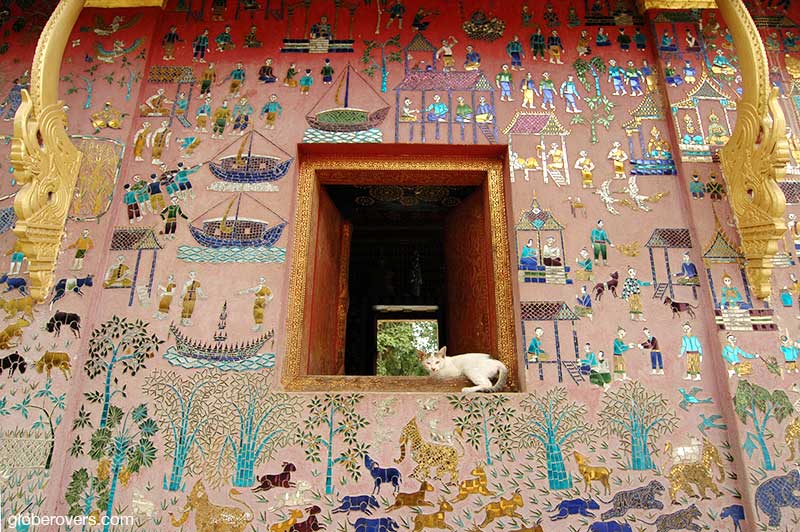
One of the reasons many people come here is to appreciate and photograph a special event which plays out around town at sunrise.
While most people are still sleeping, some are lining up along the streets of Luang Prabang to witness the Buddhist ritual of receiving early morning alms. Known as tak bat, the barefooted saffron-clad monks walk single file, oldest first, carrying their orange, copper and silver alms bowls in front of them as they are receiving their daily alms from the local devotees making merit.
Nobody speaks during this ritual as the monks walk in meditation and the almsgivers respect this symbiotic relationship by not disturbing their peace.
The alms include mostly the Lao staple of sticky rice, but can also include soups, curry, fruits, water, and even meat. For both the monks and the almsgivers, this is a special time of the day. Most laypeople will be kneeling in front of the monks, with the older monks often doing a short blessing ceremony.



Monks receiving alms early in the morning, Luang Prabang
The experience of being here is quite humbling, though some tourists think this is a cultural show to entertain them, so they stand right along the monks’ pathway to photograph them, complete with their bright flashing cameras.
Located in the heart of the mountainous region, it is a great base from where to explore northern Laos.
Sadly, the growing popularity among tourists to act irresponsibly and without respect may eventually result in the elimination of this ancient ritual.
Many monks and devotees do not want to be part of these photo sessions as they cause offence to their spiritual redemption. It is crucial that all tourists, in particular those with cameras, keep a respectful distance and do not use flashlights. This is also not the time or place to walk around in your sexy beachwear!
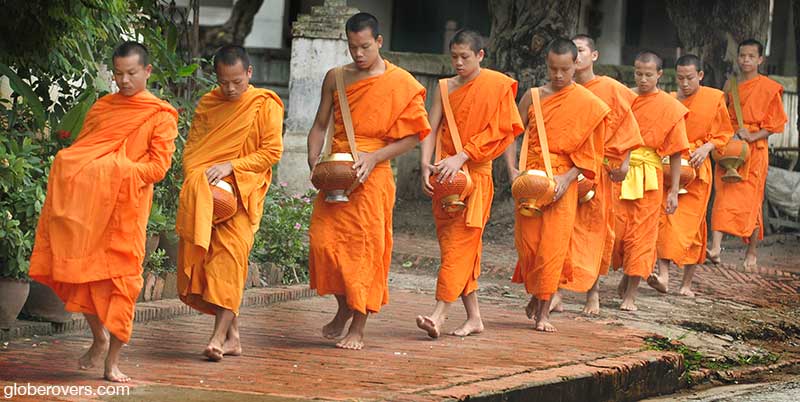
To avoid the many tourists, and it is not as bad as it sounds, visit during the wet season. This means afternoon showers with plenty of sunshine during the rest of the day.
The wettest months are August and September when there may be flooding around the Mekong River. The wet season has the least tourists and you may often find yourself quite alone, which is great. Best is to avoid peak season, which is December and January.
☛ Read more: 9 Must-Do’s in Laos
The Hill Tribes
The northern part of Laos is home to several ethnic minorities such as the Khmu, Hmong and the Yuan. The Khmu people build their houses on two levels, with the main living area elevated on stilts to protect them from invading animals and critters. They live in the lowlands as well as in the green belt halfway up the hills. The ethnic Lao people regard the Khmu as the first inhabitants of the area and they believe the Khmu have power over the local spirits. While most are animists, some are Christians and Buddhist.
Spending a day in the life of the hill tribes is a highlight of this region.
A second prominent ethnic group is the Hmong who descended from the Yellow River basin of central China before settling in the southern provinces of China during the 18th century. Since then many have migrated to the rugged uplands of northern Vietnam, Laos, Thailand, and the eastern parts of Myanmar. The Hmong people’s cultural life and religious beliefs are extremely interesting, and it is a rewarding experience to spend a day or more among these people. With the help of a local guide who can be the translator, you will be amazed at the stories they tell.
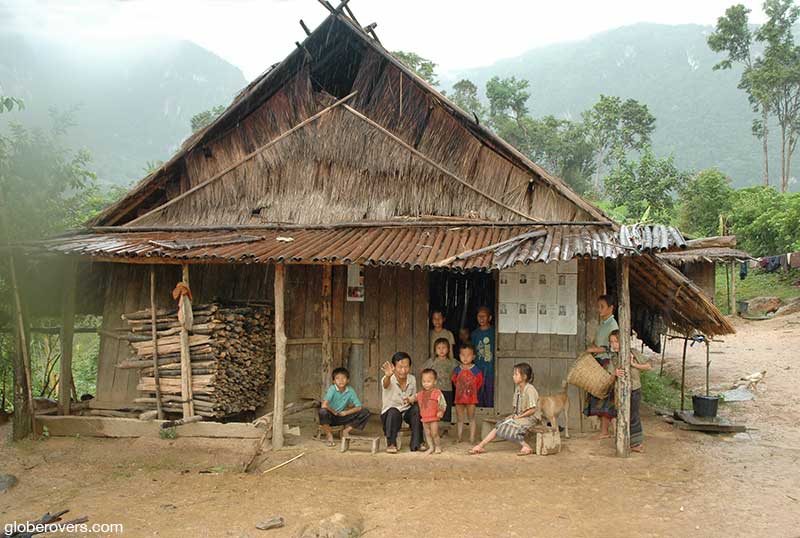
The Hmong people who live around Luang Prabang are generally not well-to-do and are often in need of basic necessities. However, they are friendly towards visiting travellers. They live in the hills and highlands, with their homes built on bare earth, rather than raised above the ground on stilts. Many homes are without any significant flooring, other than a clay floor. Houses consist of one or two rooms, with the entire family sleeping on raised bamboo beds.
Make sure to meet the local shaman of the village, who is the person believed to possess special powers through ecstatic religious acts. He is responsible for the religious and medical well-being of the village which he does by communicating with the spiritual world where he often asks for advice and prophecies.
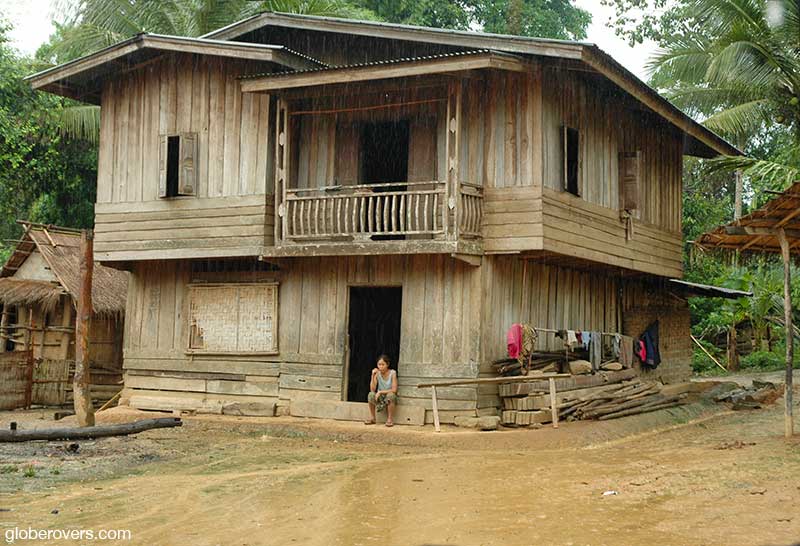
As a visitor to a Hmong village, it is good practice to first visit the village chief, and literally “ask permission” to enter the village. You will almost always be granted your request, and probably be invited into his home, meet his family, and have a cup of tea.
A day or two, even three or four, are well spent trekking the lowlands, highlands, and the hills in search of the ethnic tribes of Laos.
☛ Read more: Island-hopping the Mekong River’s 4,000 Islands
Once you have soaked up all the excitement of Luang Prabang and everything around it, head straight north to the village of Nong Khiaw along the banks of the Nam Ou River, then by boat further north to Muang Ngoi, and continue on to go trekking in the Muang Khua and Phongsali areas. You will be delighted with northern Laos.
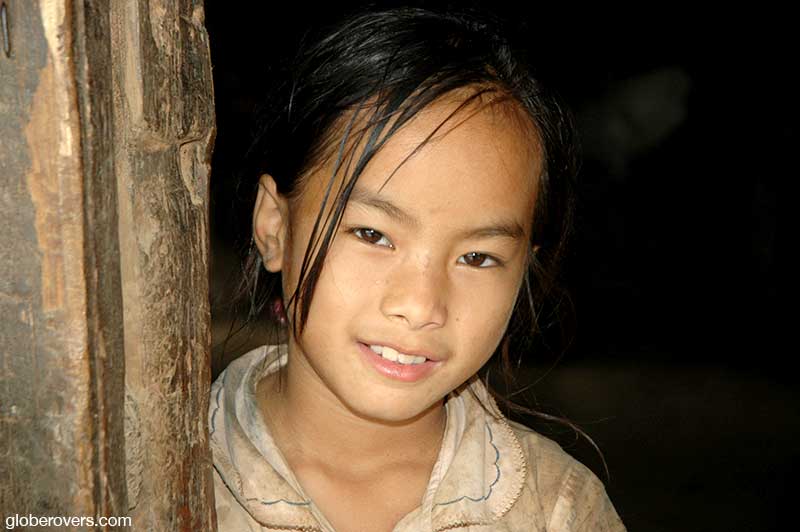


Further reading
- The Best Things To Do in Laos
- A Mini Guide to Travelling Luang Prabang, Laos
- Why You Should Drop What You’re Doing and Travel to Laos Right Now

Blog post and photos by Peter who has been travelling almost full-time since 2005 and has been to over 122 countries. He visited several countries, such as Japan, more than 20 times. Peter is Editor-in-Chief and Publisher of GlobeRovers Magazine, an independent travel magazine focused on intrepid destinations.

